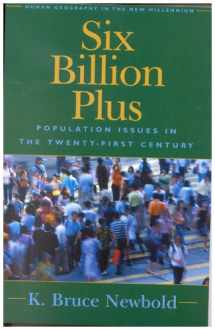
Six Billion Plus: World Population in the Twenty-first Century (Human Geography in the Twenty-First Century: Issues and Applications)
ISBN-13:
9780742516168
ISBN-10:
0742516164
Author:
K Bruce Newbold
Publication date:
2002
Publisher:
Rowman & Littlefield Publishers
Format:
Hardcover
224 pages
FREE US shipping
Book details
ISBN-13:
9780742516168
ISBN-10:
0742516164
Author:
K Bruce Newbold
Publication date:
2002
Publisher:
Rowman & Littlefield Publishers
Format:
Hardcover
224 pages
Summary
Six Billion Plus: World Population in the Twenty-first Century (Human Geography in the Twenty-First Century: Issues and Applications) (ISBN-13: 9780742516168 and ISBN-10: 0742516164), written by authors
K Bruce Newbold, was published by Rowman & Littlefield Publishers in 2002.
With an overall rating of 3.6 stars, it's a notable title among other
books. You can easily purchase or rent Six Billion Plus: World Population in the Twenty-first Century (Human Geography in the Twenty-First Century: Issues and Applications) (Hardcover) from BooksRun,
along with many other new and used
books
and textbooks.
And, if you're looking to sell your copy, our current buyback offer is $0.38.
Description
Six Billion Plus explores world population growth and its implications for the twenty-first century. With a population currently exceeding six billion and expected to reach ten billion by mid-century, the world's demographic situation is more critical than ever, by almost any measure. While the developed world faces its own problems with an aging population and population decline, most of the growth will occur in the developing world. And so the strongest factors shaping the global environment in the decades to come will include population fertility, social and economic impacts of the HIV/AIDS epidemic, legal and illegal immigration, and refugees. The implications are enormous; population growth exacerbates food and resource scarcities, places pressure on institutions, and promotes the potential for conflict. Drawing on a geographical perspective and using examples from around the world, this compact, illustrated, and accessible text is ideal for population courses in geography as well as in areas such as economics, sociology, and politics.


We would LOVE it if you could help us and other readers by reviewing the book
Book review

Congratulations! We have received your book review.
{user}
{createdAt}
by {truncated_author}


